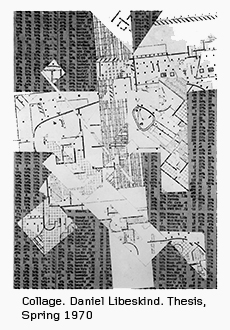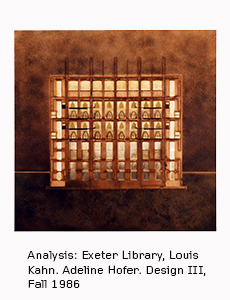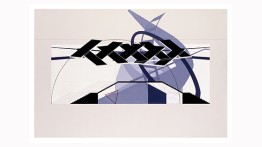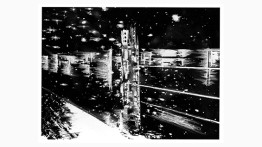Architecture Archive Awarded Grant
POSTED ON: September 28, 2016
This month, The Irwin S. Chanin School of Architecture Archive was awarded a federal grant of $149,736 to organize, catalog and digitize its Student Work Collection. The grant from the Institute of Museum and Library Services (IMLS) Museums for America program will support the school in translating this unique resource into a public, web-based database. “Not only will this enable us to multiply our audiences, but it effectively allows us to share the pedagogical heritage of the school with the world at large,” Dean Nader Tehrani says. “I am delighted to share this news with our alumni, whose work is the subject of this archive, and also pleased to be able to speak to our prospective students to help them better understand the ethics and discipline that underlie this work.”
The Student Work Collection is the core collection of the Architecture Archive, and with over 30,000 items, the largest. The Archive has documented about 4,000 student projects dating back to the 1930s. Over eight decades of architectural pedagogy at the school are captured by this significant photographic collection of drawings, small and large-scale models, supplemental sketches and project descriptions. In addition to the Student Work Collection, the Archive has collections of architectural blueprints and construction prints, lantern slides, New York City postcards, architectural travel photos and New York City waterfront images.
 Documenting and preserving student work in the School of Architecture began as a project-based effort in 1970 when John Hejduk and Roger Canon established a methodology for the exhibition, Education of An Architect: A Point of View, at the Museum of Modern Art in 1971. This groundbreaking exhibition coincided with a publication of the same name and traveled nationwide, providing greater recognition for the school. The School of Architecture Archive was established in 1983 and became a department of the school in 1991, with Kim Shkapich A‘80 as its first director. In recent years, the office has received research requests from around the world, typically to study the faculty and evolution of the school’s pedagogy. While the Archive’s staff makes every effort to fulfill these requests, limited resources and the lack of an advanced cataloging system have made researching the collection challenging. All of that is about to change.
Documenting and preserving student work in the School of Architecture began as a project-based effort in 1970 when John Hejduk and Roger Canon established a methodology for the exhibition, Education of An Architect: A Point of View, at the Museum of Modern Art in 1971. This groundbreaking exhibition coincided with a publication of the same name and traveled nationwide, providing greater recognition for the school. The School of Architecture Archive was established in 1983 and became a department of the school in 1991, with Kim Shkapich A‘80 as its first director. In recent years, the office has received research requests from around the world, typically to study the faculty and evolution of the school’s pedagogy. While the Archive’s staff makes every effort to fulfill these requests, limited resources and the lack of an advanced cataloging system have made researching the collection challenging. All of that is about to change.
Today, Steven Hillyer, a 1990 graduate of the School of Architecture, is the Director of the Architecture Archive. “Here at The Cooper Union, we have remarkable collections, including the the Library’s Cooper Archives and the Herb Lubalin Study Center of Design and Typography. With this grant, the Archive’s most valuable and unique collection will see the light of day and become an accessible resource, both internally and externally,” Hillyer says. Hillyer not only manages the process of acquiring new student work for the Archive each year, but has curated numerous exhibitions that often include materials from the Archive. “Over the years, we have been working to develop a formal archive environment, and this is a major step toward that,” he says. “There are very few architecture schools with a public-facing student work collection, especially that covers the breadth and scope of ours. This effort has been a longstanding goal of mine, to make the history of the school’s pedagogy fully accessible and public.”
Applying for the grant was a collaborative process among the Archive staff and leadership, School of Architecture faculty and the Office of Alumni Affairs and Development. “We expected that this would be a competitive grant program and, as such, part of the application needed to communicate the potential interest of what is a very focused collection to a wide audience,” Associate Dean Elizabeth O’Donnell says. “The collection documents student work, but reveals as well the radical changes in architectural theory, practice and the tools of architectural investigation and representation over the last fifty years. Crafting this argument was a collaborative effort."
 This year, IMLS awarded grants under this particular program to 206 of 548 applicants. The Cooper Union was one of 35 institutions of higher education included. “It is significant for us that a federal agency is acknowledging the value of our collection,” remarks Chris Dierks, the Collections Assistant for the Archive, who was a driving force behind the grant. The school will be seeking matching funds to cover the remaining costs of the project.
This year, IMLS awarded grants under this particular program to 206 of 548 applicants. The Cooper Union was one of 35 institutions of higher education included. “It is significant for us that a federal agency is acknowledging the value of our collection,” remarks Chris Dierks, the Collections Assistant for the Archive, who was a driving force behind the grant. The school will be seeking matching funds to cover the remaining costs of the project.
The forthcoming process involves organizing and preserving the collection at the item-level, filling in missing information, scanning items and creating a searchable digital catalog. As part of the process, the Archive will be reaching out to alumni to obtain copyright permissions and additional information about particular items in the collection. The online inventory will be categorized by student authors, faculty name, academic year, typology and other classifications to assist researchers. Whirl-i-Gig, a Brooklyn-based team led by 1993 chemical engineering graduate Seth Kaufman, is customizing its CollectiveAccess platform for the project’s web-based interface. The intended beta launch for the digital archive will be in 2018. “We are excited for this opportunity to engage with The Cooper Union’s community and to share the work of the school with local, national and international audiences,” Dierks says.







